This post may contain affiliate links. Please read our disclosure policy.
This Sourdough Croissant Bread Recipe is the newest addition to every baker’s repertoire. Made with just a few basic ingredients combined with love and patience, this loaf has layers of butter that will melt in your mouth with every bite.

Are you someone who enjoys a nice lunch sandwich or maybe a sweet(Nutella, huint hint!) or savory toast for breakfast? I know I do, and I don’t think I could come up with a better bread to start with than this. Just think about it, is there anything that helps enhance the overall flavor of a bite better than rich butter and a subtle tang? Soups, sauces, syrups, meats, and cheeses. You name it, this bread will make everything better and is what your meals are missing.
Now I know all of that sounds good, but I’m guessing there’s a chance you’re getting nervous or a little intimidated with taking this task on. Well, don’t be! This recipe requires two things: being patient and keeping your ingredients cold, that’s it. If you can do that, you’ll end up with a loaf that will impress everyone and make them think you’re a baking master.
Since you are here and love sourdough recipes, check out this Simple Sourdough Starter Recipe for Beginners, this Small Batch Sourdough Bread Recipe, or this Sourdough Bagels Recipe.
Table of Contents
- How does sourdough croissant bread taste like?
- Ingredients for this Croissant Sourdough Bread Recipe
- How to make this Sourdough Croissant Bread Recipe
- Croissant Sourdough Bread Recipe Tips and Tricks for Best Results
- Why do you need to make this recipe?
- Frequently Asked Questions – FAQ
- The Best Croissant Sourdough Bread Recipe
- Croissant Sourdough Bread Recipe
- If you enjoyed this Croissant Sourdough Bread Recipe, make sure to pin it for later!
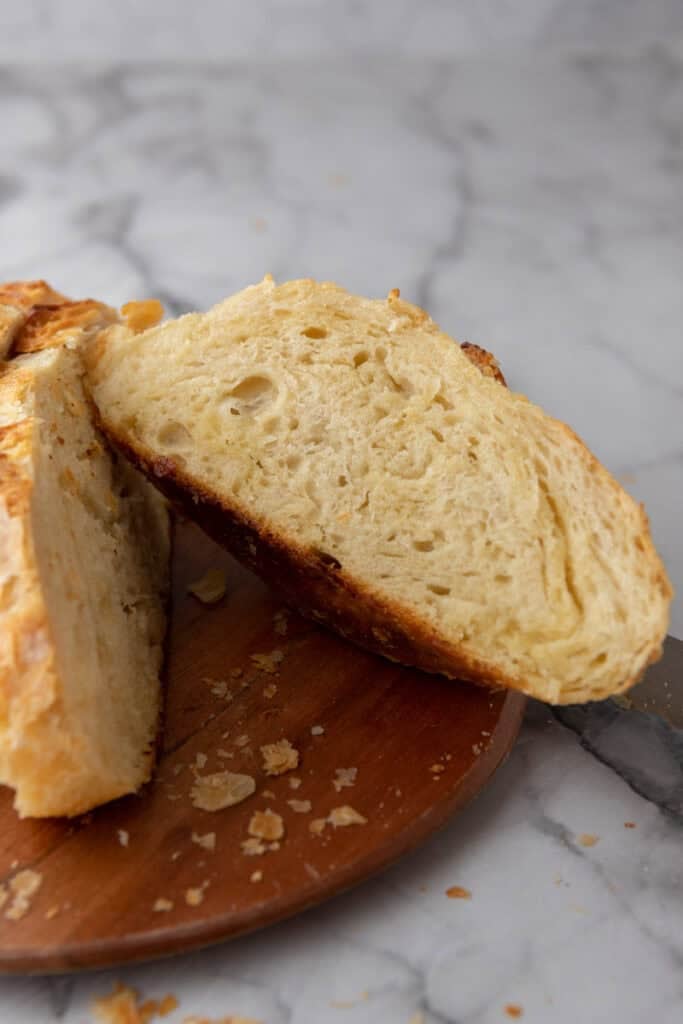
How does sourdough croissant bread taste like?
This bread pretty much tastes like a croissant slice. The outside is insanely flakey as you can probably hear from the video, while also being so soft and buttery in the center. Since we are almost laminating our bread the same way croissant dough is laminated, you also get a strong croissant like flavor which reminded me of that Trader Joes croissant loaf bread (but better).
It is honestly the best marriage between sourdough and croissant in both textures and flavors. The mixture of the sour and tang from the sourdough pairs incredible well with the butter flavor as well, so the balance is surreal. Truly a culinary experience that you can recreate in the comfort of your own home.
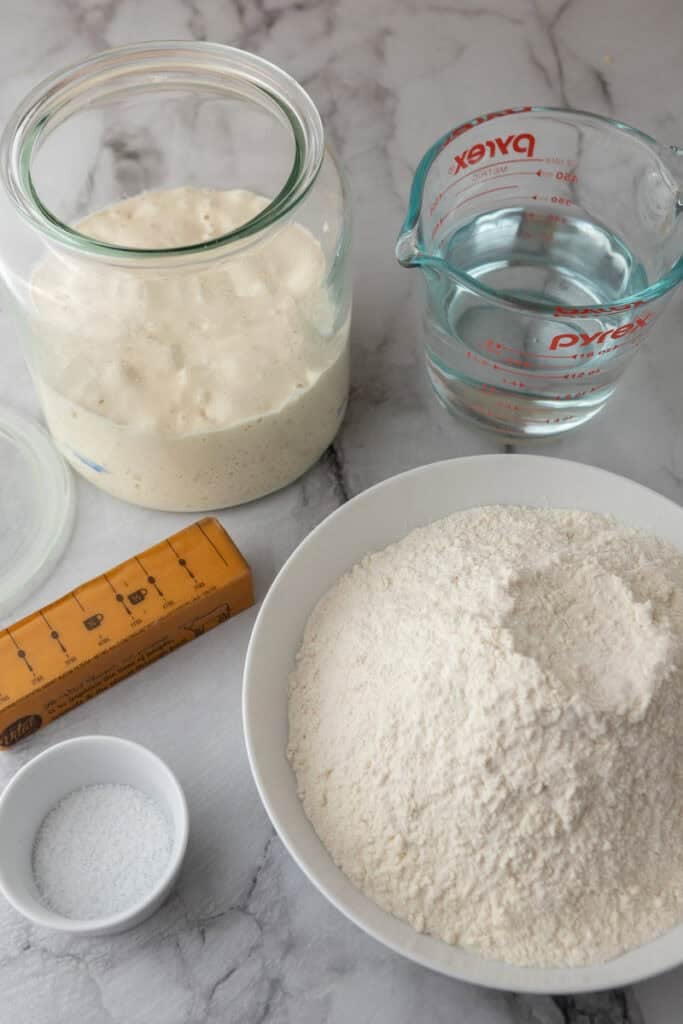
Ingredients for this Croissant Sourdough Bread Recipe
Here are the ingredients you will need to make this sourdough croissant loaf. Scroll down to the recipe card at the bottom of the page for the detailed ingredient measurements.
- Water: provides hydration to the dough and helps activate gluten formation in the flour.
- Active Sourdough Starter: acts as the leavening agent and contributes to the rise and flavor development of the bread. No need for commercial yeast in this recipe!
- Bread Flour: is used because it contains higher protein content than all-purpose flour.
- Salt: enhances the flavor of the bread, regulates yeast activity, and strengthens gluten development.
- Unsalted Butter: high-quality butter creates butter layers within the dough during the lamination process, contributing to the texture that’s reminiscent of flaky croissants.

How to make this Sourdough Croissant Bread Recipe
This is how you can make a sourdough loaf with buttery layers. Make sure to scroll down to the recipe card at the end of this post for the oven temp, bake times, and full step-by-step instructions!
Mix the Dough Ingredients
- In a large mixing bowl, combine the flour, water, active starter, and salt, stirring until everything is fully incorporated.
- Cover the bowl with a damp cloth and let the dough rest for 30 minutes to allow the flour to fully absorb the moisture.
Recipe Tip: If you have the time, let the flour, 320g water, and sourdough starter sit for 30-60 minutes before adding salt and the 30g leftover water. This allows the flour to fully hydrate, improving elasticity and texture.
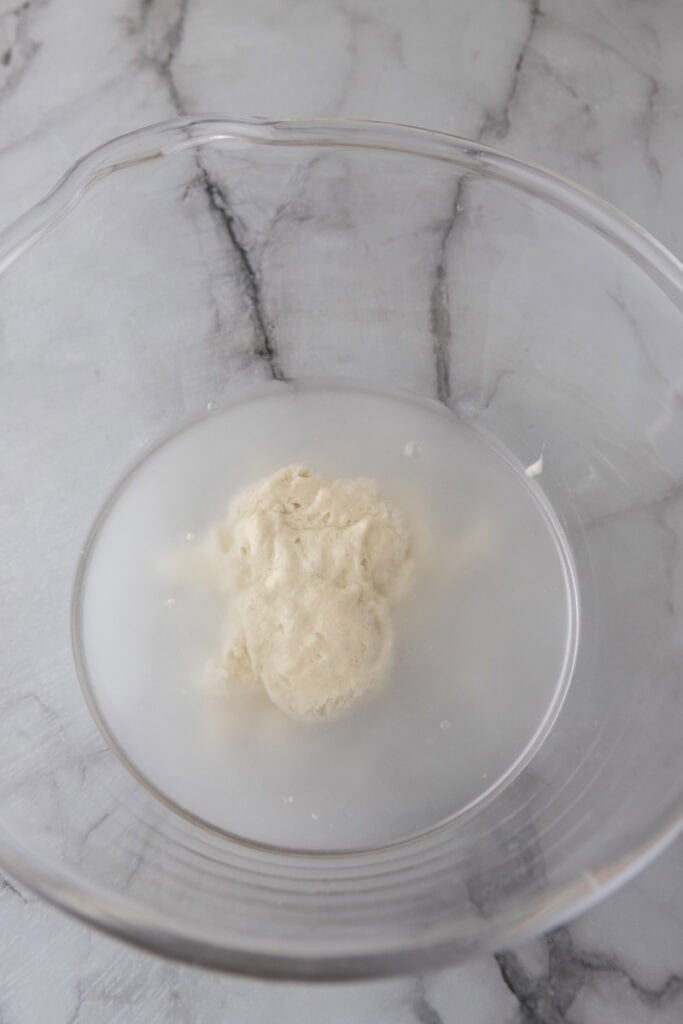
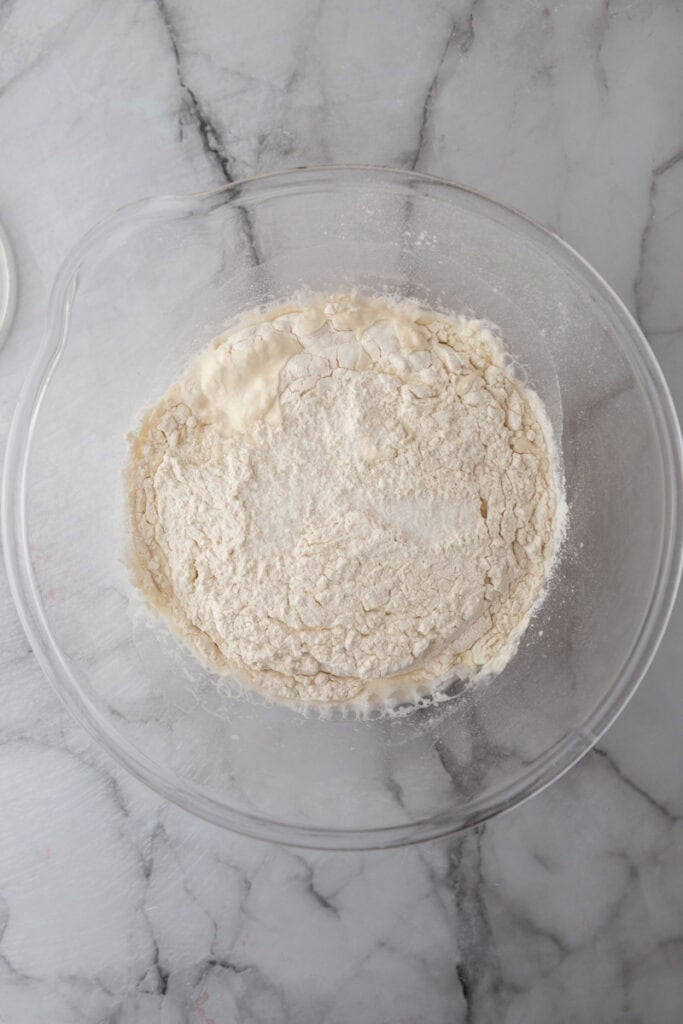
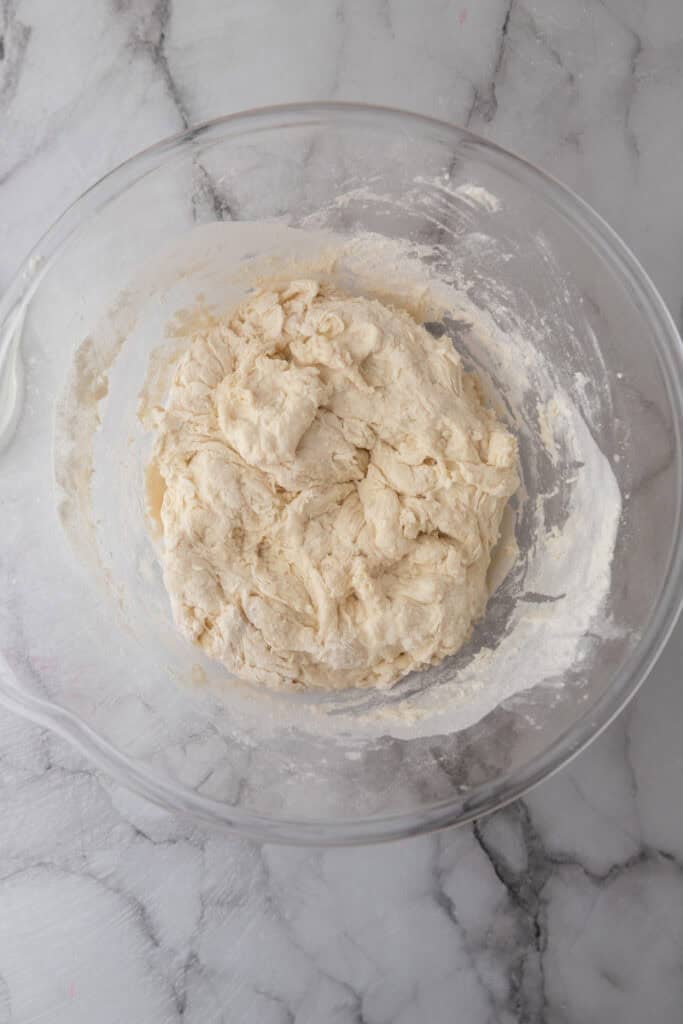

Stretch, Fold & Incorporate Butter
Perform a series of four stretch-and-folds, spacing each one 30 minutes apart.
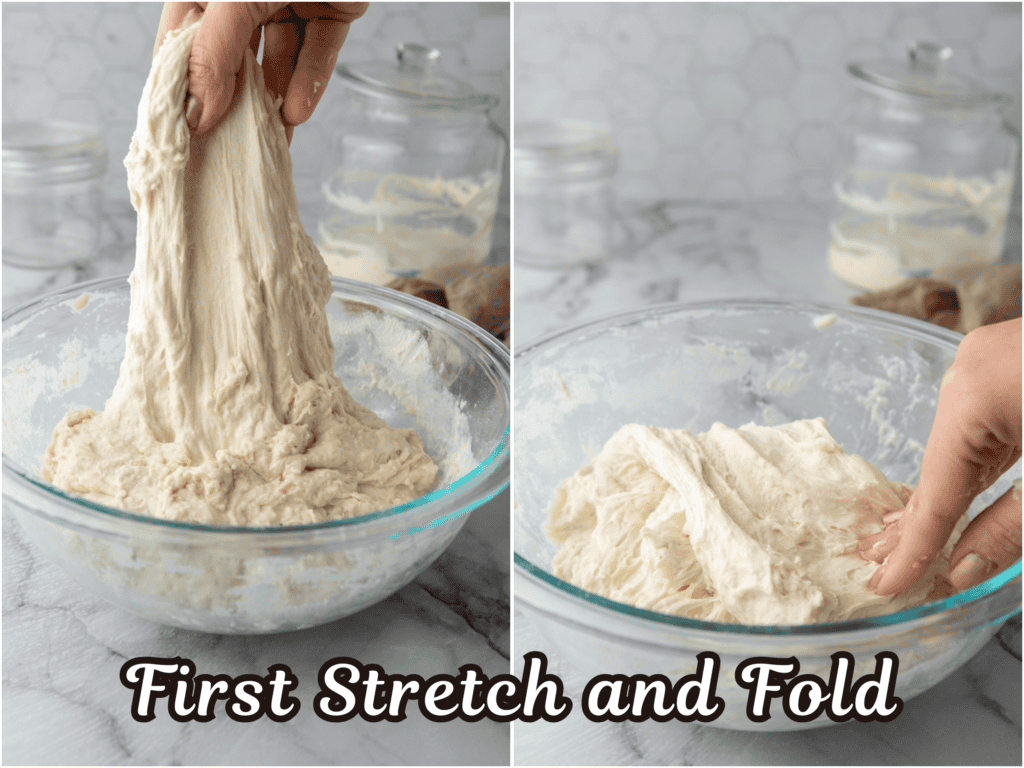
- Perform four sets of stretch and folds every 30 minutes.
- Do the first stretch and fold without adding any butter, this is done to make the dough smoother and more elastic before the next step.
- During the second stretch and fold, grate half of the cold butter directly over the dough and fold it in. Cover and allow it to rest for 30 minutes.
- On the third stretch and fold, add the remaining butter and fold again. Continue folding until the butter is well incorporated. Cover and rest for another 30 minutes.

- For the fourth and final stretch and fold, follow the same motion as before, but without adding any additional butter.
Recipe Tip: Keep the butter chilled in the fridge between stretch-and-folds to ensure the butter stays as cold as possible.
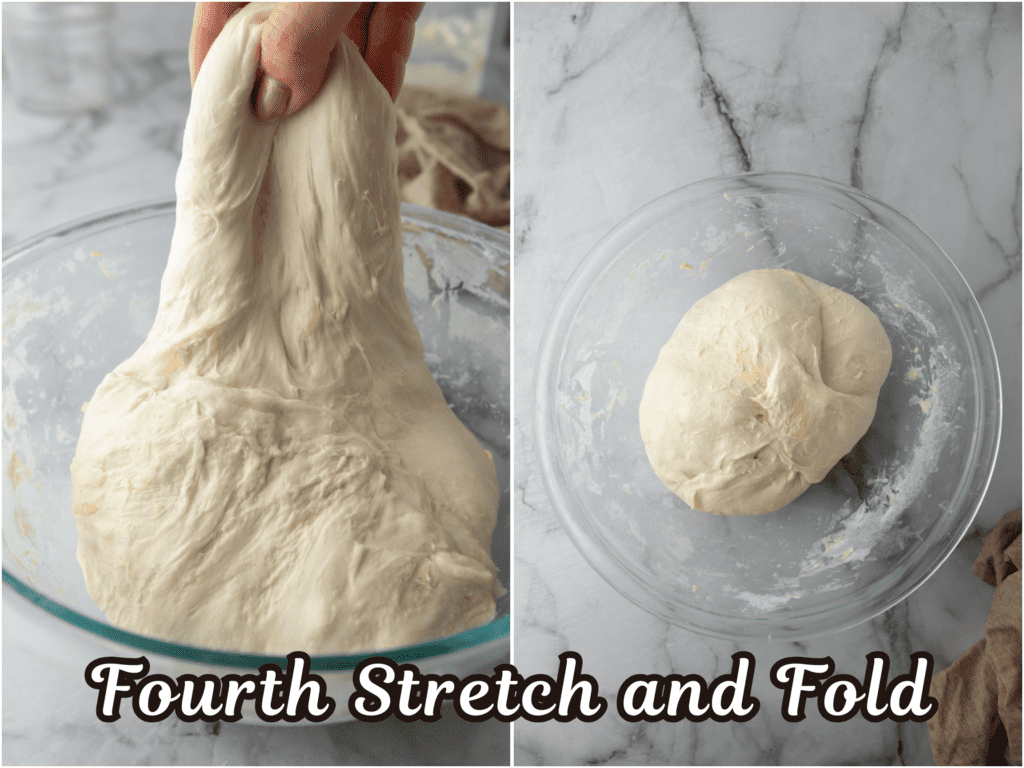
Bulk Fermentation
- Cover the dough and let it rise at room temperature range (70-72°F) for 6-7 hours, or until it has expanded about two-thirds of the way and has visible bubbles forming at the bottom of the glass bowl.
- Be sure to monitor the dough’s temperature periodically using a thermometer to maintain an optimal environment.
Recipe Tip: Set your thermostat in your house at 72 degrees for these 7 hours to ensure your bread ferments properly. If your kitchen is on the cooler side, you can extend this process to 8-9 hours for a deeper sourdough tang. Now,if your kitchen is warm, check the dough around 5-6 hours instead of 7. If it doubles in size too fast, move it to the fridge earlier.

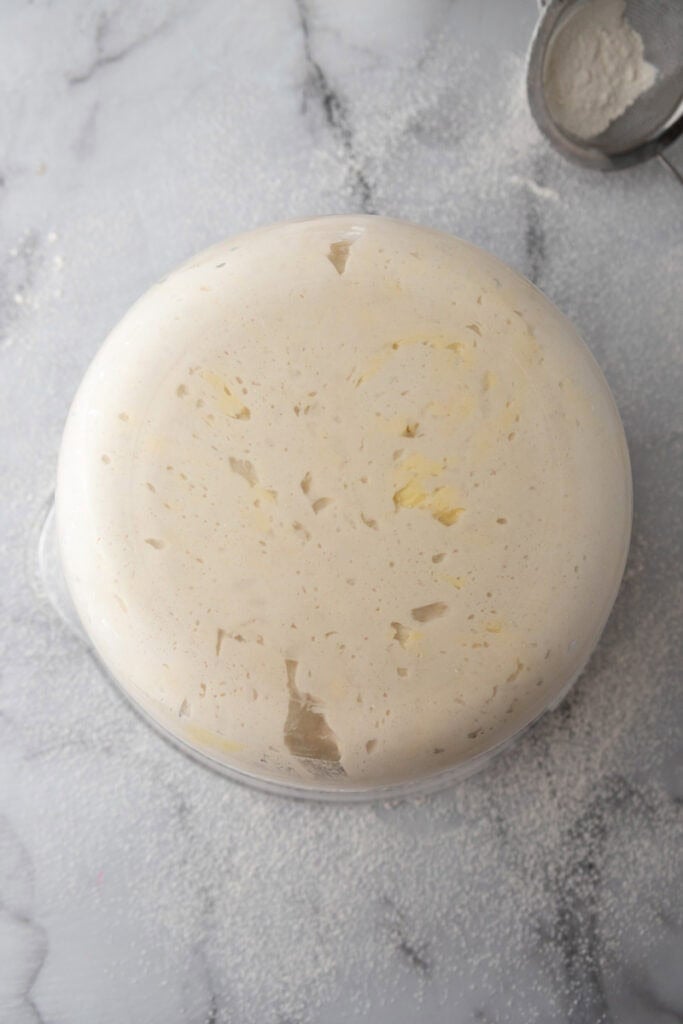
Pre-Shaping & Cold Proofing
Lightly dust your work surface with just enough flour to prevent sticking without overloading it, as too much flour can affect how the dough seals.
- Lightly flour your work surface. Use just enough flour to prevent sticking, but not too much or it will affect how the dough seals.
- Gently turn out the dough on the lightly floured surface. Place the dough upside down from the bowl onto the floured surface. Try not to deflate it too much; you want to keep the air bubbles intact.
- Gently flatten the dough into a rough rectangle (do not press too hard to keep air pockets intact). Fold the top third down toward the center, like folding a letter.
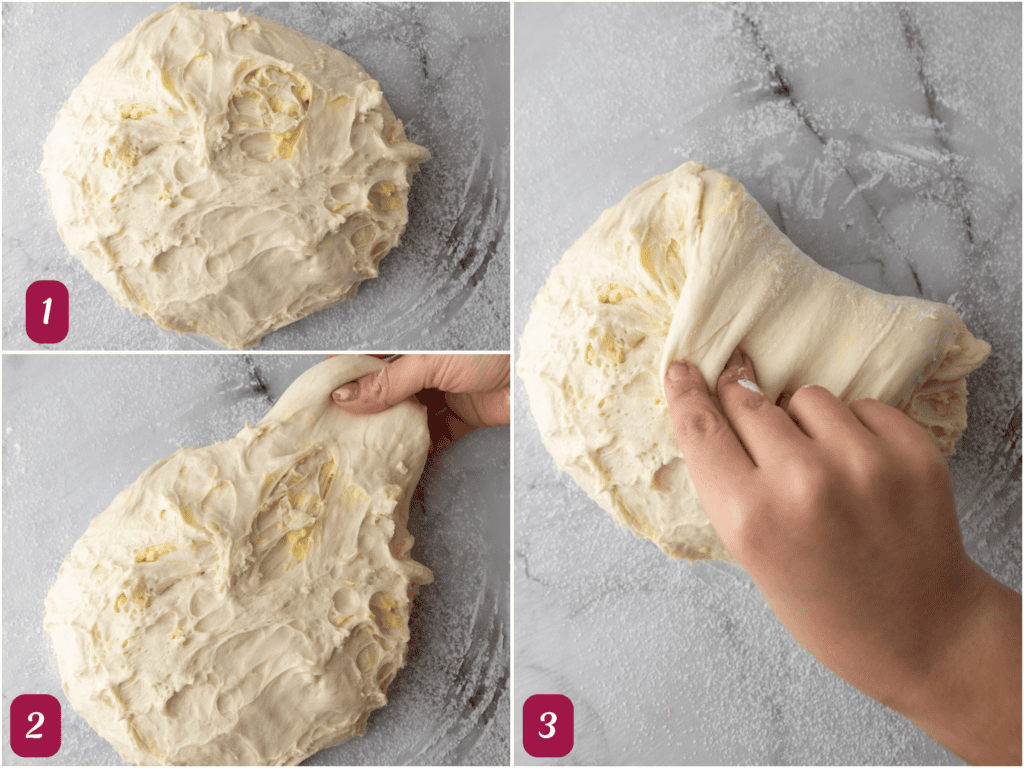
- Fold the bottom third up over the previous fold.
- Rotate 90° and gently pull the edges in toward the center, tucking them under to create surface tension.
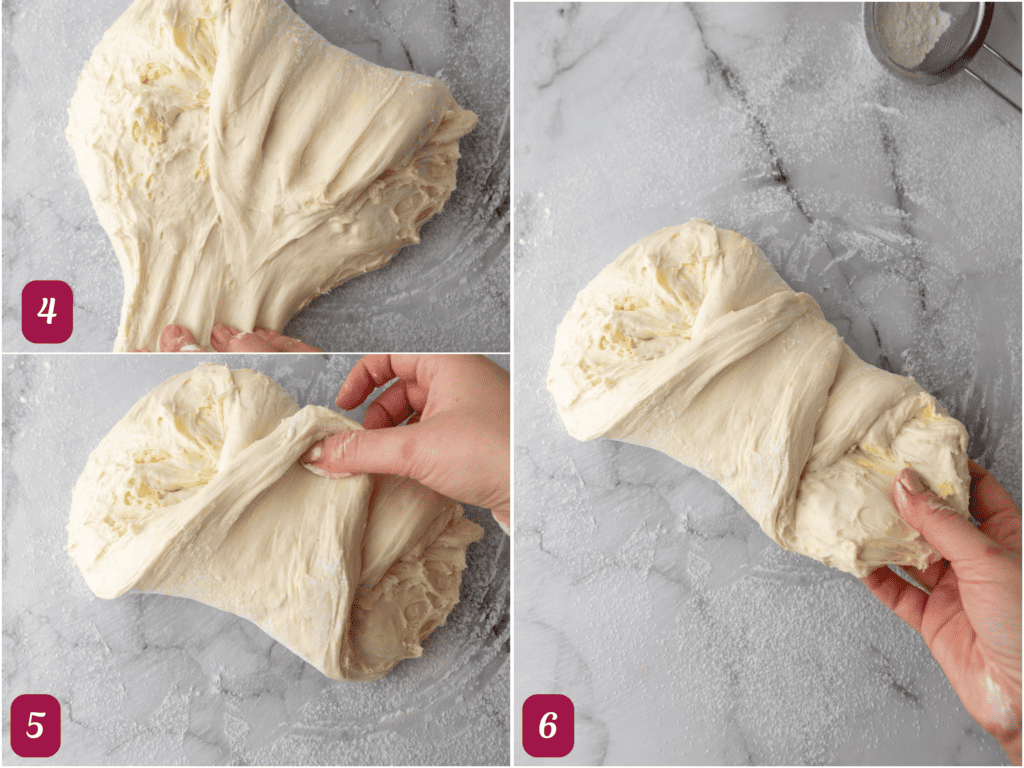
- We are shaping it into a ball in this recipe, so keep moving your hand in a C shape it make a tight boule. Using a bench scraper, pick it up and place it smooth side down onto the floured baneton.

- Let it rest for 10-20 minutes then seal the top before covering it with plastic wrap and refrigerating overnight (8-12 hours) for better flavor.
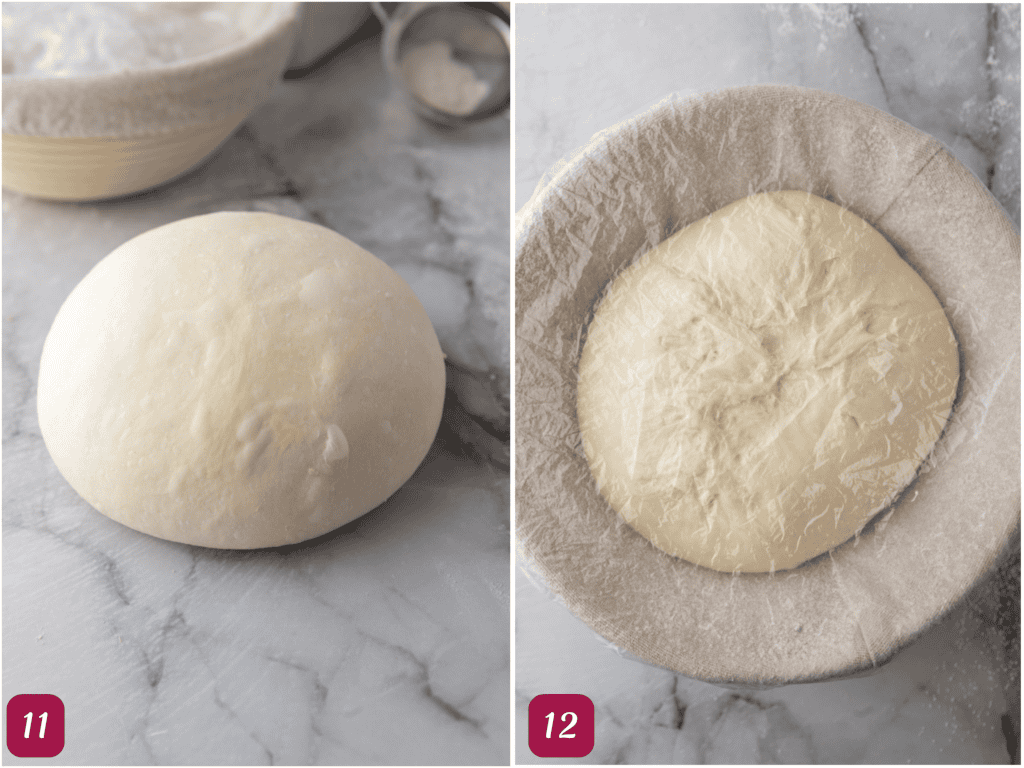
Scoring & Baking
- The next day, preheat the oven with a Dutch oven inside.
- Take the cold dough out of the refrigerator, place it on a sheet of parchment paper, and use a sharp blade to score the top of the dough with a sharp knife or razor blade.
- Transfer the chilled dough into the preheated Dutch oven, place some ice cubes on the outside of the parchment paper to create steam, cover it with the lid, and bake.
- Remove the lid, reduce the oven temperature a little and continue baking until the crust turns a deep golden brown.
- Allow the bread to cool before slicing to let the crumb fully set.
Recipe Tip: If the crust is browning too fast in the oven, reduce the temperature for the last 10 minutes. Also, let the loaf cool completely before slicing because if you do it too soon, it can result in a gummy texture. I would suggest waiting at least an hour.
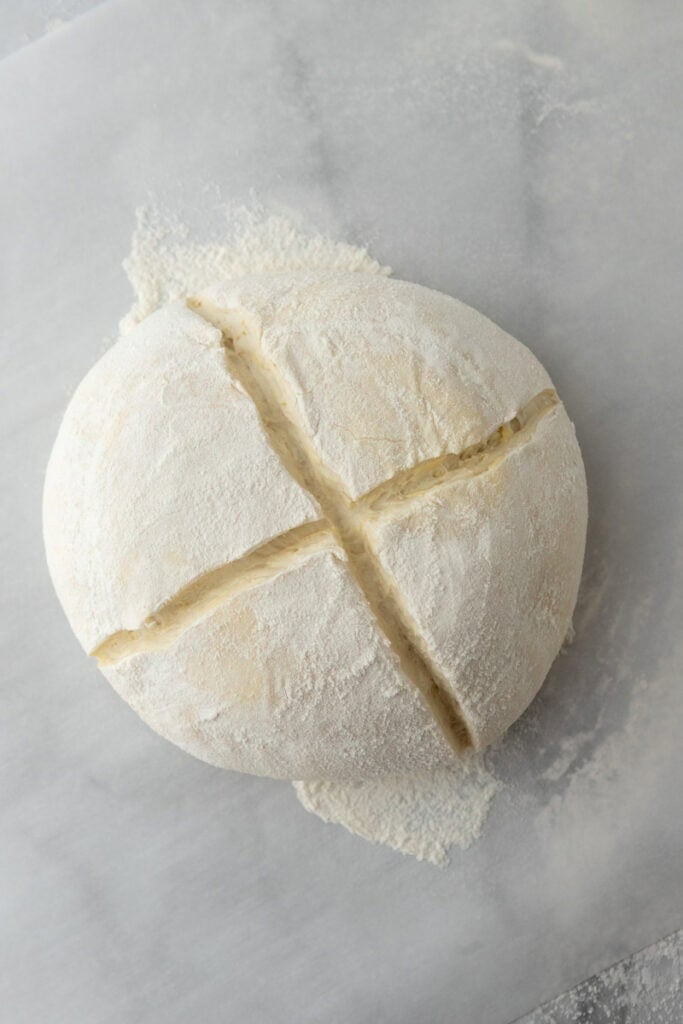
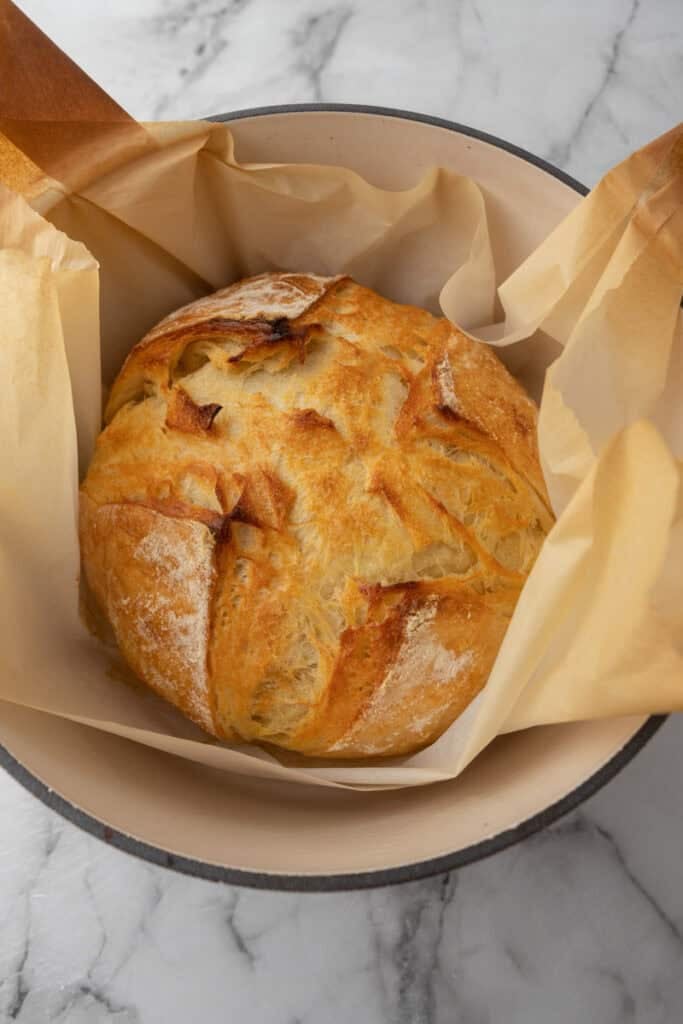

Croissant Sourdough Bread Recipe Tips and Tricks for Best Results
- Use the Highest-Quality Butter You Can Find: European butter, Amish butter, or other types of artisanal butters will give you the best flavor.
- Adjust Your Salt Levels: If using salted butter, make sure to reduce your salt amount a little so that it isn’t overly salty.
- Adjust Hydration if Needed: Depending on your flour, you may need slightly more or less water. If the dough feels too dry, add a splash more; if it’s too sticky, let it rest longer before working with it.
- Work Quickly to Keep the Butter Cold: is the main thing to focus on. If the dough feels too warm (which usually happens in the summer) while folding in the butter, pop it in the fridge for 15 minutes to keep the layers intact.
- Steam for Extra Crispiness: If not using a Dutch oven, place a small pan of boiling water in the oven during the first 20 minutes of baking to create steam and achieve a crispier crust. You could also do this even when using a dutch oven by adding a few ice cubes between the dutch oven and the parchment paper before closing the lid.
- Check Internal Temperature with a Thermometer: The bread is fully baked when the internal temp reaches 200-205°F in the center of the dough.
- Add a Baking Tray on The Bottom Rack: Some ovens run a little hot so adding a baking sheet on the bottom rack will help keep the bottom of your sourdough bread golden and not burn or too hard.
Why do you need to make this recipe?
- This recipe is the ultimate way to combine the best of both worlds for people who love tangy sourdough and the flaky layers of croissant dough.
- This is the kind of bread that makes you feel like a true artisan baker. It looks impressive and tastes amazing.
- It’s an incredibly versatile loaf that can be enjoyed in many delicious ways, both sweet and savory.
- It honestly just tastes delicious and is worth giving it a shot. It might just become your new favorite!
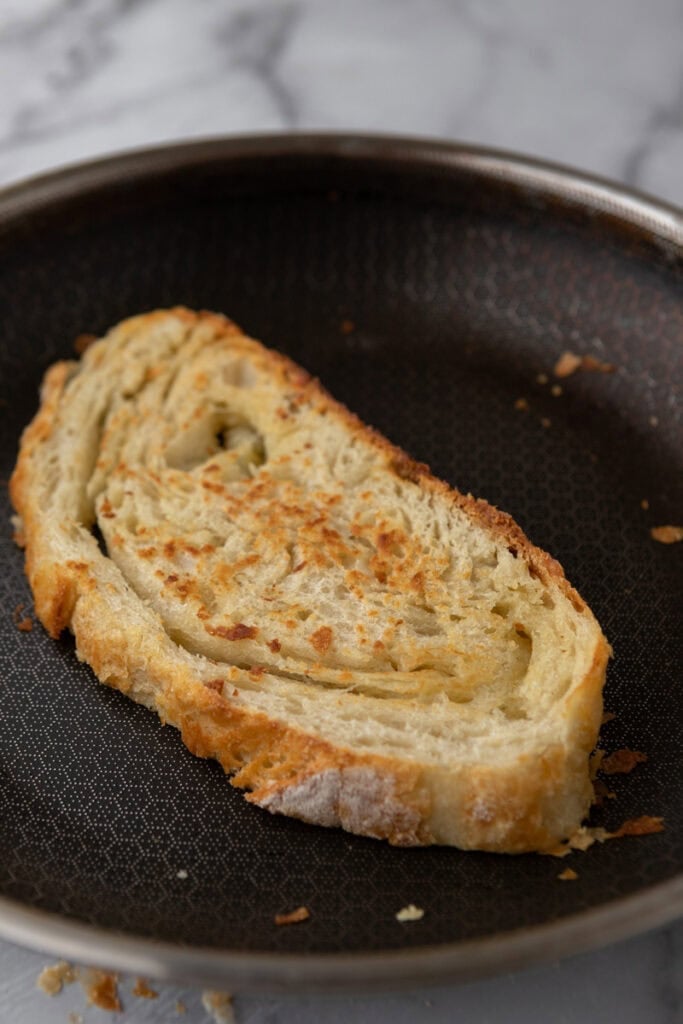
Frequently Asked Questions – FAQ
What type of flour should I use?
A strong bread flour with at least 12-13% protein helps develop a better gluten structure, leading to a chewy and airy texture.
How am I supposed to grate the butter?
The best way to grate butter is to freeze it beforehand. Cold butter creates distinct layers so it’s imperative that we keep it as cold as possible. Make sure the butter block is in the freezer until you’re ready to grate and incorporate it. I make sure to keep the butter that is used in the third stretch and fold inclusion in the freezer while our dough is resting as well.
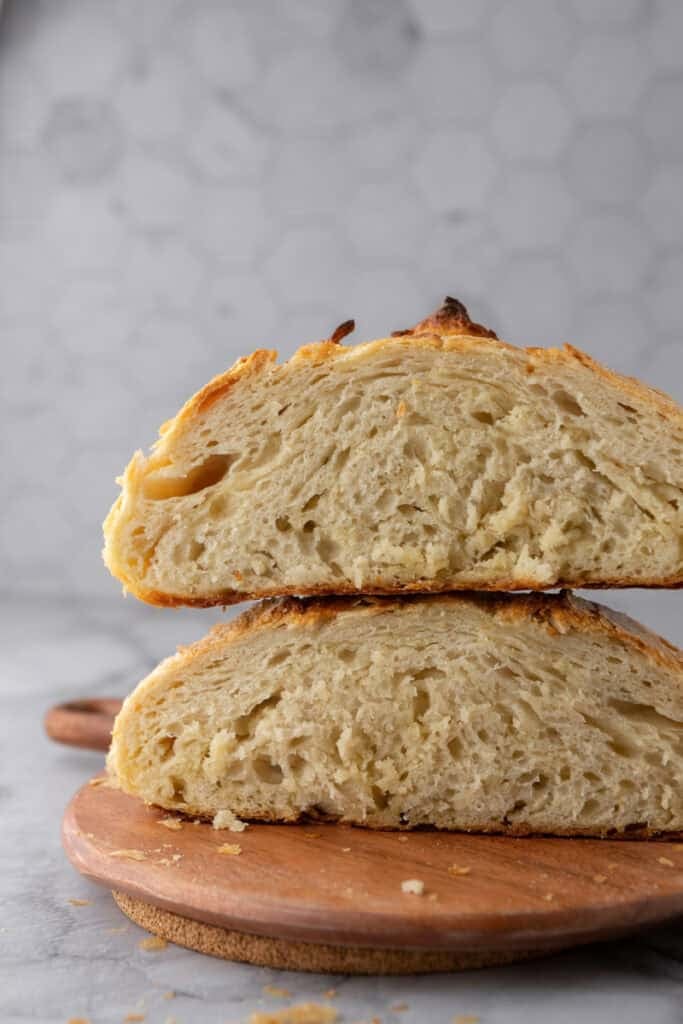
Do I really have to let it proof overnight?
I know this recipe takes multiple days, and we can all get impatient in trying to satisfy our sourdough craving, but I promise you it’s worth it. Allowing for slow fermentation overnight in the fridge enhances flavor and helps firm up the butter, making it easier to handle during baking.
Why isn’t my dough rising during bulk fermentation?
If your dough isn’t rising properly, it could be for a couple of reasons. First, your sourdough starter may not be active enough. You want to make sure it has been recently fed and is doubling in size within 4-6 hours. If not, re-do it. Secondly, your kitchen might be too cold. You could try placing the dough in a slightly warmer spot (around 70°F-74°F) or extending the fermentation time.
This step is pretty tricky for this specific recipe because we don’t want our dough to get too warm since we want to make sure the butter doesn’t melt, so don’t worry about your dough not rising fast because the temperature is going to make this process pretty slow. Increase your bulk fermentation time to 9-10 hours or whoever much time your dough needs to rise.

Can I use all-purpose flour instead of bread flour for this Croissant Sourdough Bread Recipe?
Yes, you can. However, the dough may be softer and slightly harder to handle since all-purpose flour has less protein. If you do choose to use AP flour, reduce the water slightly to prevent stickiness.
Why is my Croissant Sourdough Bread dense instead of light and airy?
If the dough is dense, that might be due to under-fermenting. Make sure your starter is strong, and allow enough time for bulk fermentation. Also, avoid over-mixing to a certain extent, we want to keep in as much of those gasses in our sourdough as possible. Over-handling the dough during shaping can also knock out air pockets, while handling it gently helps to preserve its structure.
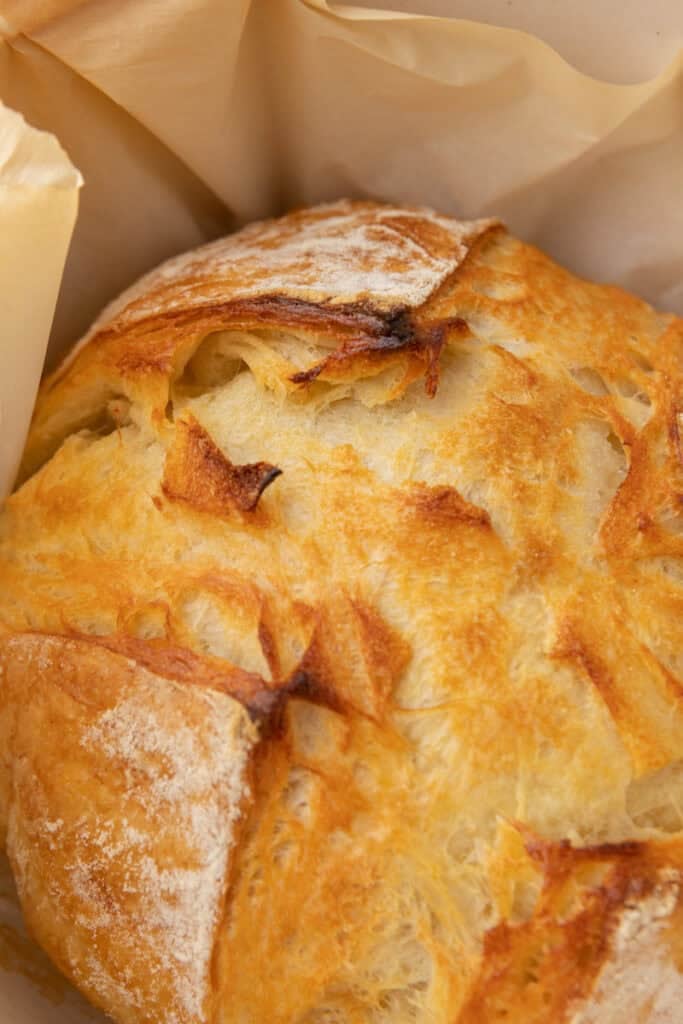
How do I store leftover bread?
You can store your leftovers in a sealable plastic bag or any airtight container. You can keep it out at room temperature and it will stay fresh for 3 days. Or you can keep it in the fridge for up to a week or in the freezer for up to a month. If you want to store it for even longer, wrap your loaf or slices tightly in plastic wrap, followed by aluminum foil, and store in the freezer. Make sure to either toast, air fry, or heat up in the oven so you get the full experience and flavors of this croissant bread!
How can I serve/enjoy this croissant bread?
There are an abundance of uses that I totally suggest you try:
- When you first cut into it, give it a drizzle of honey, a sprinkle of salt, or a shmear of whatever sweet or savory spread you like and enjoy it fresh.
- Toast a slice and spread some butter on it for the true experience of homemade sourdough croissants.
- Spread some Nutella on it after toasting, this will give it a vibe of chocolate croissants!
- Use this for your next avocado breakfast toast.
- Try it toasted with jams and nut butters.
- Move over brioche, this might just be the best French toast base ever. I’ve made French toast in the past using sourdough, and I can tell you that using this bread would be an absolute game-changer with it.
- It’s perfect for building PB&J’s or deli meat and cheese sandwiches.
- Since this bread is buttery and flaky, it makes an incredible bread pudding.
- Try it on the side or as a crouton topping for your soup.

The Best Croissant Sourdough Bread Recipe

Sourdough Croissant Bread
Ingredients
Dough:
- 350 g water about 1 ½ cups minus 1 tbsp, room temperature
- 100 g active sourdough starter (100% hydration) about ½ cup
- 500 g bread flour about 3 ¾ cups
- 10 g salt about 1 ¾ tsp, use less if you're using salted butter
Butter Layer:
- 113 g unsalted butter cold from the freezer, grated (1/2 cup)
Instructions
Step 1: Prepare the Dough
- In a large bowl, mix together flour, water, sourdough starter, and salt until fully combined.350 g water, 100 g active sourdough starter (100% hydration), 500 g bread flour, 10 g salt
- Cover with a damp towel and let it rest for 30 minutes to allow the flour to hydrate.
Step 2: Stretch & Folds with Butter Incorporation
- Perform four sets of stretch and folds every 30 minutes.
- Do the first stretch and fold without adding any butter, this is done to make the dough smoother and more elastic before the next step.
- During the second stretch and fold, grate half of the cold butter directly over the dough and fold it in. Cover and allow it to rest for 30 minutes. Place the rest of the butter back in the freezer.113 g unsalted butter
- On the third stretch and fold, add the remaining butter and fold again. Continue folding until the butter is well incorporated. Cover and rest for another 30 minutes.
- On the fourth stretch and fold, just do the same step as the previous stretch and fold but without adding any more butter.
Step 3: Bulk Fermentation
- Cover and let the dough rise at room temperature (70-72°F) for 6-7 hours until it has risen about 2/3 of the way and has visible bubbles that you can see at the bottom of your glass bowl.
- If the dough gets too warm, refrigerate it for 20-30 minutes to keep the butter from melting. (It's crucial to check your dough temperature everytime you work with it, and every few hours to make sure it isn't too hot)
Step 4: Pre-Shaping & Cold Proofing
- Lightly flour your work surface. Use just enough flour to prevent sticking, but not too much or it will affect how the dough seals.
- Gently turn out the dough. Place the dough upside down from the bowl onto the floured surface. Try not to deflate it too much; you want to keep the air bubbles intact.
- Gently flatten the dough into a rough rectangle (do not press too hard to keep air pockets intact). Fold the top third down toward the center, like folding a letter.
- Fold the bottom third up over the previous fold.
- Rotate 90° and gently pull the edges in toward the center, tucking them under to create surface tension. We are shaping it into a ball in this recipe, so keep moving your hand in a C shape it make a tight boule. Using a bench scraper, pick it up and place it smooth side down onto the floured baneton. Let it rest for 10-20 minutes then seal the top before covering it with plastic wrap and refrigerating overnight (8-12 hours) for better flavor.
Step 5: Scoring & Baking
- Preheat the oven to 450°F (230°C) with a Dutch oven inside for at least 30 minutes.
- Remove the dough from the fridge, place it on parchment paper, and score the top with a sharp blade.
- Transfer into the hot Dutch oven, cover, and bake for 30 minutes covered.
- Remove the lid, reduce the heat to 390F (198°C) and bake for another 15-20 minutes until deep golden brown and the internal temperature reaches 200°F.
Step 6: Cooling & Serving
- Transfer the bread to a cooling rack as soon as it comes out of the oven and let it cool for at least 1 hour before slicing to allow the crumb to set.
- Enjoy the flaky, buttery sourdough croissant bread with jam, honey, Nutella, or on its own!
Nutrition
Nutrition information is automatically calculated, so should only be used as an approximation.
If you enjoyed this Croissant Sourdough Bread Recipe, make sure to pin it for later!
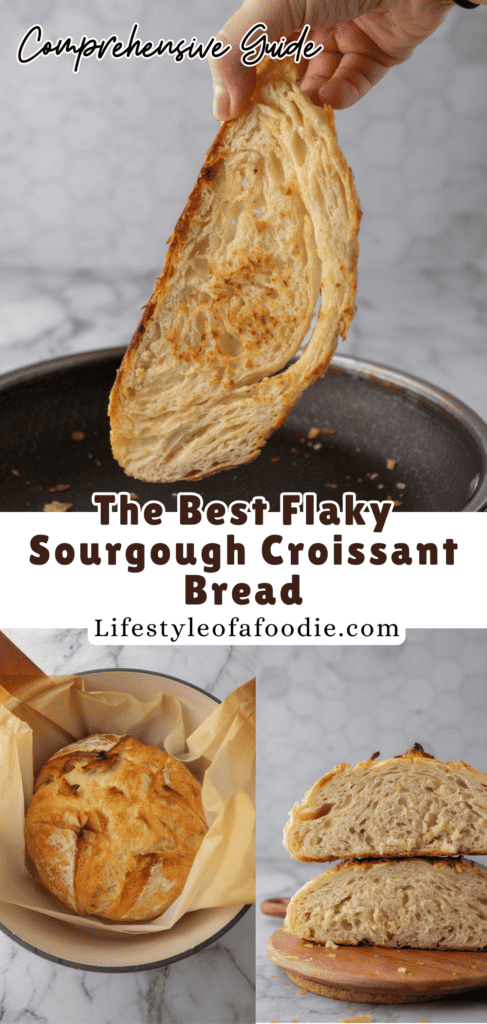



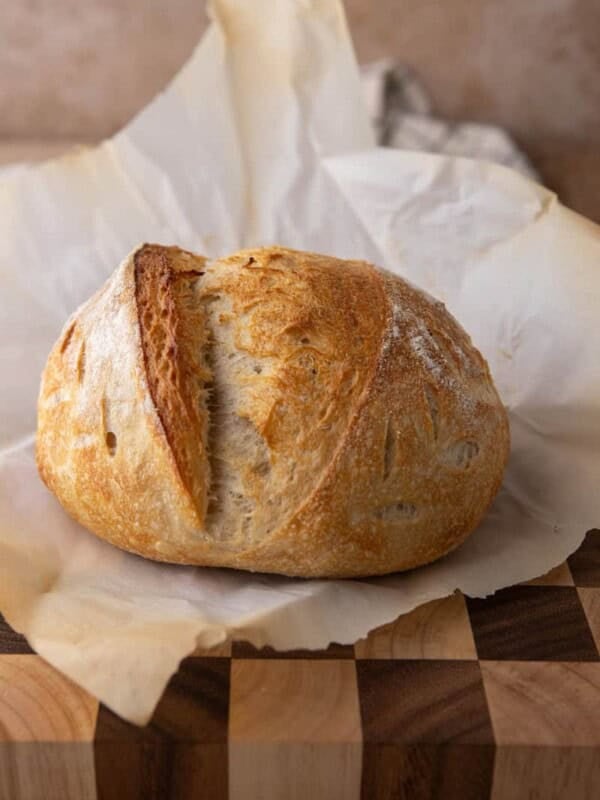



thank you for the recipe, love it!!!
Glad you enjoyed 🙂
Can I use fresh milled flour for this recipe?
I’ve never tried it before but research says it should work 🙂
Hi! What size dutch oven do you use for one recipe
The 5-quart 🙂
OMG! This is probably the best sourdough I have ever made!!! I was nervous about the butter melting and kept my eye on it. It is the most flaky wonderful crust!!
Yesss!! That makes me so happy to hear!! I’m so glad you trusted the process, even with the butter stress and it paid off with that flaky, gorgeous crust! Sounds like you nailed it 🔥 Let me know if you ever want to try a flavored version next!
I know I’m replying to a comment that I didn’t start, but I just wanted to say that this bread was AMAZING! I saw the suggestion to let you know if the other commenter would like to try a flavored version. I would LOVE to try one! I have been making this bread every week for over a month, and I absolutely love it. I’m also very interested in how to change it up a bit for some variety.
RIGHT! This croissant-style sourdough is my personal favorite as well! For adding flavors, you can make/buy and use a compound butter instead of regular butter. Get a compound butter that’s been enhanced with cinnamon sugar, herbs and spices, or minced garlic bits.
AMAZING, out of this world buttery and flakey! My husband and friends made some incredible breakfast sandwiches out of this loaf!! Will be regularly made in our home!
So happy to hear that!! I’m thrilled you and your husband (and friends!) loved it. The idea of using it for breakfast sandwiches sounds incredible, definitely stealing that one! Thanks so much for making it part of your home baking rotation 💛
This is a brilliant recipe. It turned out beautifully. Stupid me didnt read unsalted butter so I have 2 quite salty loaves 😅 but bake wise it’s ridiculously good. Thank you for the recipe:)
Hahaha! that mistake happens to the best of us. Glad you liked the recipe though !
I made this and it turned out amazing!
I love to hear that 🙂
113 g of butter total or at each stretch and fold?
113 grams total so 1/2 a stick of cold shredded butter for this whole recipe!
Hi there! Would you be kind to share an active starter recipe please?
Of course! Here it is, Simple Sourdough Starter Recipe for Beginners